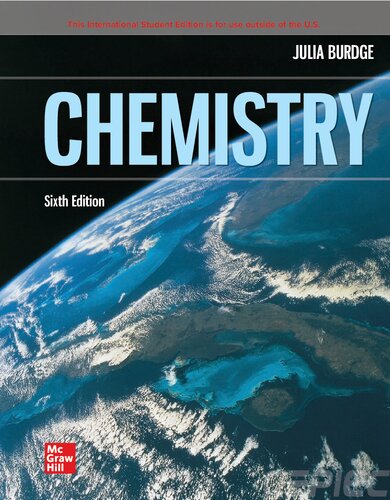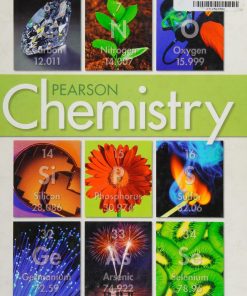(EBook PDF) Chemistry 6th Edition by Julia Burdge 1264507798 9781264507795 full chapters
$50.00 Original price was: $50.00.$25.00Current price is: $25.00.
Chemistry 6th Edition by Julia Burdge – Ebook PDF Instant Download/DeliveryISBN: 1264507798, 9781264507795
Full download Chemistry 6th Edition after payment

Product details:
ISBN-10 : 1264507798
ISBN-13 : 9781264507795
Author: Julia Burdge
Chemistry
Chemistry 6th Table of contents:
1 Chemistry: The Central Science
1.1 The Study of Chemistry
• Chemistry You May Already Know
■ How Can I Enhance My Chances of Success in Chemistry Class?
• The Scientific Method
1.2 Classification of Matter
• States of Matter
• Elements
• Compounds
• Mixtures
1.3 Scientific Measurement
• SI Base Units
• Mass
• Temperature
■ Fahrenheit Temperature Scale
• Derived Units: Volume and Density
■ Why Are Units So Important?
1.4 The Properties of Matter
• Physical Properties
• Chemical Properties
• Extensive and Intensive Properties
1.5 Uncertainty in Measurement
• Significant Figures
• Calculations with Measured Numbers
■ What’s Significant About Significant Figures?
• Accuracy and Precision
1.6 Using Units and Solving Problems
• Conversion Factors
• Dimensional Analysis—Tracking Units
2 Atoms, Molecules, and Ions
2.1 The Atomic Theory
2.2 The Structure of the Atom
• Discovery of the Electron
• Radioactivity
• The Proton and the Nucleus
• Nuclear Model of the Atom
• The Neutron
2.3 Atomic Number, Mass Number, and Isotopes
2.4 The Periodic Table
■ Distribution of Elements on Earth
2.5 The Atomic Mass Scale and Average Atomic Mass
2.6 Ions and Ionic Compounds
• Atomic Ions
• Polyatomic Ions
• Formulas of Ionic Compounds
• Naming Ionic Compounds
• Oxoanions
• Hydrates
2.7 Molecules and Molecular Compounds
• Molecular Formulas
• Naming Molecular Compounds
• Simple Acids
• Oxoacids
• Empirical Formulas of Molecular Substances
2.8 Compounds in Review
3 Stoichiometry: Ratios of Combination
3.1 Molecular and Formula Masses
3.2 Percent Composition of Compounds
3.3 Chemical Equations
• Interpreting and Writing Chemical Equations
• Balancing Chemical Equations
■ The Stoichiometry of Metabolism
3.4 The Mole and Molar Masses
• The Mole
• Determining Molar Mass
• Interconverting Mass, Moles, and Numbers of Particles
• Empirical Formula from Percent Composition
3.5 Combustion Analysis
• Determination of Empirical Formula
• Determination of Molecular Formula
3.6 Calculations with Balanced Chemical Equations
• Moles of Reactants and Products
• Mass of Reactants and Products
3.7 Limiting Reactants
• Determining the Limiting Reactant
Limiting Reactant Problems
• Reaction Yield
• Types of Chemical Reactions
4 Reactions in Aqueous Solutions
4.1 General Properties of Aqueous Solutions
• Electrolytes and Nonelectrolytes
• Strong Electrolytes and Weak Electrolytes
• Identifying Electrolytes
4.2 Precipitation Reactions
• Solubility Guidelines for Ionic Compounds in Water
• Molecular Equations
• Ionic Equations
• Net Ionic Equations
4.3 Acid-Base Reactions
• Strong Acids and Bases
• Brønsted Acids and Bases
• Acid-Base Neutralization
4.4 Oxidation-Reduction Reactions
• Oxidation Numbers
• Oxidation of Metals in Aqueous Solutions
• Balancing Simple Redox Equations
• Other Types of Redox Reactions
4.5 Concentration of Solutions
• Molarity
Preparing a Solution from a Solid
• Dilution
• Serial Dilution
• Solution Stoichiometry
■ How Are Solution Concentrations Measured?
4.6 Aqueous Reactions and Chemical Analysis
• Gravimetric Analysis
• Acid-Base Titrations
• Redox Titration
5 Thermochemistry
5.1 Energy and Energy Changes
• Forms of Energy
• Energy Changes in Chemical Reactions
• Units of Energy
5.2 Introduction to Thermodynamics
• States and State Functions
• The First Law of Thermodynamics
• Work and Heat
5.3 Enthalpy
• Reactions Carried Out at Constant Volume or at Constant Pressure
• Enthalpy and Enthalpy Changes
• Thermochemical Equations
5.4 Calorimetry
• Specific Heat and Heat Capacity
• Constant-Pressure Calorimetry
Determination of ΔH°rxn by Constant-Pressure Calorimetry
■ Heat Capacity and Hypothermia
• Constant-Volume Calorimetry
Determination of Specific Heat by Constant-Pressure Calorimetry
■ What if the Heat Capacity of the Calorimeter Isn’t Negligible?
5.5 Hess’s Law
5.6 Standard Enthalpies of Formation
6 Quantum Theory and the Electronic Structure of Atoms
6.1 The Nature of Light
• Properties of Waves
• The Electromagnetic Spectrum
• The Double-Slit Experiment
6.2 Quantum Theory
• Quantization of Energy
■ Laser Pointers
• Photons and the Photoelectric Effect
■ Where Have I Encountered the Photoelectric Effect?
6.3 Bohr’s Theory of the Hydrogen Atom
• Atomic Line Spectra
• The Line Spectrum of Hydrogen
Emission Spectrum of Hydrogen
■ Lasers
6.4 Wave Properties of Matter
• The de Broglie Hypothesis
• Diffraction of Electrons
6.5 Quantum Mechanics
• The Uncertainty Principle
• The Schrödinger Equation
• The Quantum Mechanical Description of the Hydrogen Atom
6.6 Quantum Numbers
• Principal Quantum Number (n)
• Angular Momentum Quantum Number (ℓ)
• Magnetic Quantum Number (mℓ)
• Electron Spin Quantum Number (ms)
6.7 Atomic Orbitals
• s Orbitals
• p Orbitals
• d Orbitals and Other Higher-Energy Orbitals
• Energies of Orbitals
6.8 Electron Configuration
• Energies of Atomic Orbitals in Many-Electron Systems
• The Pauli Exclusion Principle
• The Aufbau Principle
• Hund’s Rule
• General Rules for Writing Electron Configurations
6.9 Electron Configurations and the Periodic Table
7 Electron Configuration and the Periodic Table
7.1 Development of the Periodic Table
■ The Chemical Elements of Life
7.2 The Modern Periodic Table
• Classification of Elements
• Representing Free Elements in Chemical Equations
7.3 Effective Nuclear Charge
7.4 Periodic Trends in Properties of Elements
• Atomic Radius
• Ionization Energy
• Electron Affinity
• Metallic Character
• Explaining Periodic Trends
7.5 Electron Configuration of Ions
• Ions of Main Group Elements
• Ions of d-Block Elements
7.6 Ionic Radius
• Comparing Ionic Radius with Atomic Radius
• Isoelectronic Series
7.7 Periodic Trends in Chemical Properties of the Main Group Elements
• General Trends in Chemical Properties
• Properties of the Active Metals
• Properties of Other Main Group Elements
• Comparison of Group 1 and Group 11 Elements
■ Salt Substitutes
• Variation in Properties of Oxides Within a Period
8 Chemical Bonding I: Basic Concepts
8.1 Lewis Dot Symbols
8.2 Ionic Bonding
• Lattice Energy
• The Born-Haber Cycle
Born-Haber Cycle
8.3 Covalent Bonding
• Lewis Structures
• Multiple Bonds
• Comparison of Ionic and Covalent Compounds
8.4 Electronegativity and Polarity
• Electronegativity
• Dipole Moment, Partial Charges, and Percent Ionic Character
8.5 Drawing Lewis Structures
8.6 Lewis Structures and Formal Charge
8.7 Resonance
8.8 Exceptions to the Octet Rule
• Incomplete Octets
• Odd Numbers of Electrons
■ The Power of Radicals
• Expanded Octets
■ Which Is More Important: Formal Charge or the Octet Rule?
8.9 Bond Enthalpy
9 Chemical Bonding II: Molecular Geometry and Bonding Theories
9.1 Molecular Geometry
• The VSEPR Model
• Electron-Domain Geometry and Molecular Geometry
• Deviation from Ideal Bond Angles
• Geometry of Molecules with More than One Central Atom
■ How Are Larger, More Complex Molecules Represented?
9.2 Molecular Geometry and Polarity
■ Can More Complex Molecules Contain Polar Bonds and Still Be Nonpolar?
9.3 Valence Bond Theory
• Representing Electrons in Atomic Orbitals
• Energetics and Directionality of Bonding
9.4 Hybridization of Atomic Orbitals
• Hybridization of s and p Orbitals
• Hybridization of s, p, and d Orbitals
9.5 Hybridization in Molecules Containing Multiple Bonds
Formation of Pi Bonds in Ethylene and Acetylene
9.6 Molecular Orbital Theory
• Bonding and Antibonding Molecular Orbitals
• σ Molecular Orbitals
• Bond Order
• π Molecular Orbitals
• Molecular Orbital Diagrams
• Molecular Orbitals in Heteronuclear Diatomic Species
9.7 Bonding Theories and Descriptions of Molecules with Delocalized Bonding
10 Gases
10.1 Properties of Gases
• Characteristics of Gases
• Gas Pressure: Definition and Units
• Calculation of Pressure
• Measurement of Pressure
10.2 The Gas Laws
• Boyle’s Law: The Pressure-Volume Relationship
• Charles’s and Gay-Lussac’s Law: The Temperature-Volume Relationship
• Avogadro’s Law: The Amount-Volume Relationship
• The Combined Gas Law: The Pressure-Temperature-Amount-Volume Relationship
10.3 The Ideal Gas Equation
• Deriving the Ideal Gas Equation from the Empirical Gas Laws
• Applications of the Ideal Gas Equation
10.4 Reactions with Gaseous Reactants and Products
• Calculating the Required Volume of a Gaseous Reactant
• Determining the Amount of Reactant Consumed Using Change in Pressure
• Predicting the Volume of a Gaseous Product
10.5 Gas Mixtures
• Dalton’s Law of Partial Pressures
• Mole Fractions
• Using Partial Pressures to Solve Problems
Molar Volume of a Gas
■ Hyperbaric Oxygen Therapy
10.6 The Kinetic Molecular Theory of Gases
• Application to the Gas Laws
• Molecular Speed
• Diffusion and Effusion
10.7 Deviation from Ideal Behavior
• Factors That Cause Deviation from Ideal Behavior
• The van der Waals Equation
■ What’s Really the Difference Between Real Gases and Ideal Gases?
11 Intermolecular Forces and the Physical Properties of Liquids and Solids
11.1 Intermolecular Forces
• Dipole-Dipole Interactions
• Hydrogen Bonding
■ Sickle Cell Disease
• Dispersion Forces
• Ion-Dipole Interactions
11.2 Properties of Liquids
• Surface Tension
• Viscosity
• Vapor Pressure
11.3 Crystal Structure
• Unit Cells
• Packing Spheres
• Closest Packing
11.4 Types of Crystals
• Ionic Crystals
■ How Do We Know the Structures of Crystals?
• Covalent Crystals
• Molecular Crystals
• Metallic Crystals
11.5 Amorphous Solids
11.6 Phase Changes
• Liquid-Vapor Phase Transition
• Solid-Liquid Phase Transition
• Solid-Vapor Phase Transition
■ The Dangers of Phase Changes
11.7 Phase Diagrams
12 Modern Materials
12.1 Polymers
• Addition Polymers
• Condensation Polymers
■ Electrically Conducting Polymers
12.2 Ceramics and Composite Materials
• Ceramics
• Composite Materials
12.3 Liquid Crystals
12.4 Biomedical Materials
• Dental Implants
• Soft Tissue Materials
• Artificial Joints
12.5 Nanotechnology
• Graphite, Buckyballs, and Nanotubes
12.6 Semiconductors
12.7 Superconductors
13 Physical Properties of Solutions
13.1 Types of Solutions
13.2 The Solution Process
• Intermolecular Forces and Solubility
• The Driving Force for Dissolution
■ Why Are Vitamins Referred to as Water Soluble and Fat Soluble?
13.3 Concentration Units
• Molality
• Percent by Mass
• Comparison of Concentration Units
13.4 Factors That Affect Solubility
• Temperature
• Pressure
13.5 Colligative Properties
• Vapor-Pressure Lowering
• Boiling-Point Elevation
• Freezing-Point Depression
• Osmotic Pressure
• Electrolyte Solutions
■ Intravenous Fluids
■ Hemodialysis
13.6 Calculations Using Colligative Properties
13.7 Colloids
14 Chemical Kinetics
14.1 Reaction Rates
• Average Reaction Rate
• Instantaneous Rate
• Stoichiometry and Reaction Rate
14.2 Dependence of Reaction Rate on Reactant Concentration
• The Rate Law
• Experimental Determination of the Rate Law
14.3 Dependence of Reactant Concentration on Time
• First-Order Reactions
• Second-Order Reactions
14.4 Dependence of Reaction Rate on Temperature
• Collision Theory
• The Arrhenius Equation
14.5 Reaction Mechanisms
• Elementary Reactions
• Rate-Determining Step
• Experimental Support for Reaction Mechanisms
• Identifying Plausible Reaction Mechanisms
• Mechanisms with a Fast Initial Step
14.6 Catalysis
• Heterogeneous Catalysis
• Homogeneous Catalysis
• Enzymes: Biological Catalysts
■ Catalysis and Hangovers
15 Chemical Equilibrium
15.1 The Concept of Equilibrium
■ How Do We Know That the Forward and Reverse Processes Are Ongoing in a System at Equilibrium?
15.2 The Equilibrium Constant
• Calculating Equilibrium Constants
• Magnitude of the Equilibrium Constant
15.3 Equilibrium Expressions
• Heterogeneous Equilibria
• Manipulating Equilibrium Expressions
• Equilibrium Expressions Containing Only Gases
15.4 Using Equilibrium Expressions to Solve Problems
• Predicting the Direction of a Reaction
• Calculating Equilibrium Concentrations
Equilibrium (ice) Tables
15.5 Factors That Affect Chemical Equilibrium
• Addition or Removal of a Substance
• Changes in Volume and Pressure
• Changes in Temperature
• Catalysis
Le Châtelier’s Principle
Effect of Volume Change
■ What Happens to the Units in Equilibrium Constants?
■ Hemoglobin Production at High Altitude
16 Acids and Bases
16.1 Brønsted Acids and Bases
16.2 The Acid-Base Properties of Water
16.3 The pH Scale
■ Antacids and the pH Balance in Your Stomach
16.4 Strong Acids and Bases
• Strong Acids
• Strong Bases
16.5 Weak Acids and Acid Ionization Constants
• The Ionization Constant, Ka
• Calculating pH from Ka
Using Equilibrium Tables to Solve Problems
• Percent Ionization
• Using pH to Determine Ka
16.6 Weak Bases and Base Ionization Constants
• The Ionization Constant, Kb
• Calculating pH from Kb
• Using pH to Determine Kb
16.7 Conjugate Acid-Base Pairs
• The Strength of a Conjugate Acid or Base
• The Relationship Between Ka and Kb of a Conjugate Acid-Base Pair
16.8 Diprotic and Polyprotic Acids
16.9 Molecular Structure and Acid Strength
• Hydrohalic Acids
• Oxoacids
• Carboxylic Acids
16.10 Acid-Base Properties of Salt Solutions
• Basic Salt Solutions
• Acidic Salt Solutions
• Neutral Salt Solutions
• Salts in Which Both the Cation and the Anion Hydrolyze
16.11 Acid-Base Properties of Oxides and Hydroxides
• Oxides of Metals and Nonmetals
• Basic and Amphoteric Hydroxides
16.12 Lewis Acids and Bases
17 Acid-Base Equilibria and Solubility Equilibria
17.1 The Common Ion Effect
17.2 Buffer Solutions
• Calculating the pH of a Buffer
• Preparing a Buffer Solution with a Specific pH
Buffer Solutions
■ Maintaining the pH of Blood
17.3 Acid-Base Titrations
• Strong Acid–Strong Base Titrations
• Weak Acid–Strong Base Titrations
• Strong Acid–Weak Base Titrations
• Acid-Base Indicators
17.4 Solubility Equilibria
• Solubility Product Expression and Ksp
• Calculations Involving Ksp and Solubility
• Predicting Precipitation Reactions
17.5 Factors Affecting Solubility
• The Common Ion Effect
• pH
Common Ion Effect
• Complex Ion Formation
17.6 Separation of Ions Using Differences in Solubility
• Fractional Precipitation
• Qualitative Analysis of Metal Ions in Solution
18 Entropy, Free Energy, and Equilibrium
18.1 Spontaneous Processes
18.2 Entropy
• A Qualitative Description of Entropy
• A Quantitative Definition of Entropy
18.3 Entropy Changes in a System
• Calculating ΔSsys
• Standard Entropy, S°
• Qualitatively Predicting the Sign of ΔS°sys
Factors That Influence the Entropy of a System
18.4 Entropy Changes in the Universe
• Calculating ΔSsurr
• The Second Law of Thermodynamics
• The Third Law of Thermodynamics
18.5 Predicting Spontaneity
• Gibbs Free-Energy Change, ΔG
• Standard Free-Energy Changes, ΔG°
• Using ΔG and ΔG° to Solve Problems
18.6 Free Energy and Chemical Equilibrium
• Relationship Between ΔG and ΔG°
• Relationship Between ΔG° and K
18.7 Thermodynamics in Living Systems
19 Electrochemistry
19.1 Balancing Redox Reactions
19.2 Galvanic Cells
Construction of a Galvanic Cell
19.3 Standard Reduction Potentials
19.4 Spontaneity of Redox Reactions Under Standard-State Conditions
19.5 Spontaneity of Redox Reactions Under Conditions Other than Standard State
• The Nernst Equation
• Concentration Cells
■ Biological Concentration Cells
19.6 Batteries
• Dry Cells and Alkaline Batteries
• Lead Storage Batteries
• Lithium-Ion Batteries
• Fuel Cells
19.7 Electrolysis
• Electrolysis of Molten Sodium Chloride
• Electrolysis of Water
• Electrolysis of an Aqueous Sodium Chloride Solution
• Quantitative Applications of Electrolysis
19.8 Corrosion
20 Nuclear Chemistry
20.1 Nuclei and Nuclear Reactions
20.2 Nuclear Stability
• Patterns of Nuclear Stability
• Nuclear Binding Energy
20.3 Natural Radioactivity
• Kinetics of Radioactive Decay
• Dating Based on Radioactive Decay
20.4 Nuclear Transmutation
20.5 Nuclear Fission
Nuclear Fission and Fusion
20.6 Nuclear Fusion
20.7 Uses of Isotopes
• Chemical Analysis
• Isotopes in Medicine
20.8 Biological Effects of Radiation
■ Radioactivity in Tobacco
21 Environmental Chemistry
21.1 Earth’s Atmosphere
21.2 Phenomena in the Outer Layers of the Atmosphere
• Aurora Borealis and Aurora Australis
• The Mystery Glow of Space Shuttles
21.3 Depletion of Ozone in the Stratosphere
• Polar Ozone Holes
21.4 Volcanoes
21.5 The Greenhouse Effect
21.6 Acid Rain
21.7 Photochemical Smog
21.8 Indoor Pollution
• The Risk from Radon
• Carbon Dioxide and Carbon Monoxide
• Formaldehyde
22 Coordination Chemistry
22.1 Coordination Compounds
• Properties of Transition Metals
• Ligands
• Nomenclature of Coordination Compounds
22.2 Structure of Coordination Compounds
22.3 Bonding in Coordination Compounds: Crystal Field Theory
• Crystal Field Splitting in Octahedral Complexes
• Color
• Magnetic Properties
• Tetrahedral and Square-Planar Complexes
22.4 Reactions of Coordination Compounds
22.5 Applications of Coordination Compounds
■ The Coordination Chemistry of Oxygen Transport
23 Organic Chemistry
23.1 Why Carbon Is Different
23.2 Organic Compounds
• Classes of Organic Compounds
• Naming Organic Compounds
■ How Do We Name Molecules with More Than One Substituent?
■ How Do We Name Compounds with Specific Functional Groups?
23.3 Representing Organic Molecules
• Condensed Structural Formulas
• Kekulé Structures
• Bond-Line Structures
• Resonance
23.4 Isomerism
• Constitutional Isomerism
• Stereoisomerism
■ Plane-Polarized Light and 3-D Movies
■ Biological Activity of Enantiomers
23.5 Organic Reactions
• Addition Reactions
• Substitution Reactions
■ SN1 Reactions
• Other Types of Organic Reactions
■ The Chemistry of Vision
23.6 Organic Polymers
• Addition Polymers
• Condensation Polymers
• Biological Polymers
24 Metallurgy and the Chemistry of Metals (ONLINE ONLY)
24.1 Occurrence of Metals
■ The Importance of Molybdenum
24.2 Metallurgical Processes
• Preparation of the Ore
• Production of Metals
• The Metallurgy of Iron
• Steelmaking
• Purification of Metals
24.3 Band Theory of Conductivity
• Conductors
• Semiconductors
24.4 Periodic Trends in Metallic Properties
24.5 The Alkali Metals
24.6 The Alkaline Earth Metals
• Magnesium
• Calcium
24.7 Aluminum
25 Nonmetallic Elements and Their Compounds (ONLINE ONLY)
25.1 General Properties of Nonmetals
25.2 Hydrogen
• Binary Hydrides
• Isotopes of Hydrogen
• Hydrogenation
• The Hydrogen Economy
25.3 Carbon
25.4 Nitrogen and Phosphorus
• Nitrogen
• Phosphorus
25.5 Oxygen and Sulfur
• Oxygen
• Sulfur
25.6 The Halogens
• Preparation and General Properties of the Halogens
• Compounds of the Halogens
• Uses of the Halogens
People also search for Chemistry 6th:
chemistry 6th grade
chemistry paper 6 igcse
chemistry 6th grade pdf
chemistry international olympiad
chemistry 6.1
Tags:
Chemistry,Julia Burdge,
You may also like…
Education Studies & Teaching - Studying & Test Preparation
Edexcel International GCSE Chemistry Student Book Second Edition Graham Hill
Reference - School Guides & Test Preparation
Pearson Edexcel International A Level Chemistry Student Book 2 1st Edition
Chemistry - Chemistry - General & Miscellaneous
Pearson Chemistry Foundation 2012 Wilbraham 0133188523 9780133188523
Business & Economics - Management & Leadership
Business Driven Technology,10th International Student Edition Edition Paige Baltzan
Chemistry
Business & Economics - Management & Leadership
Leadership: Enhancing the Lessons of Experience 10th Edition (International Student Edition)
Business & Economics - Accounting
International Accounting 6th Edition by Timothy Doupnik 1266386275 9781266386275











